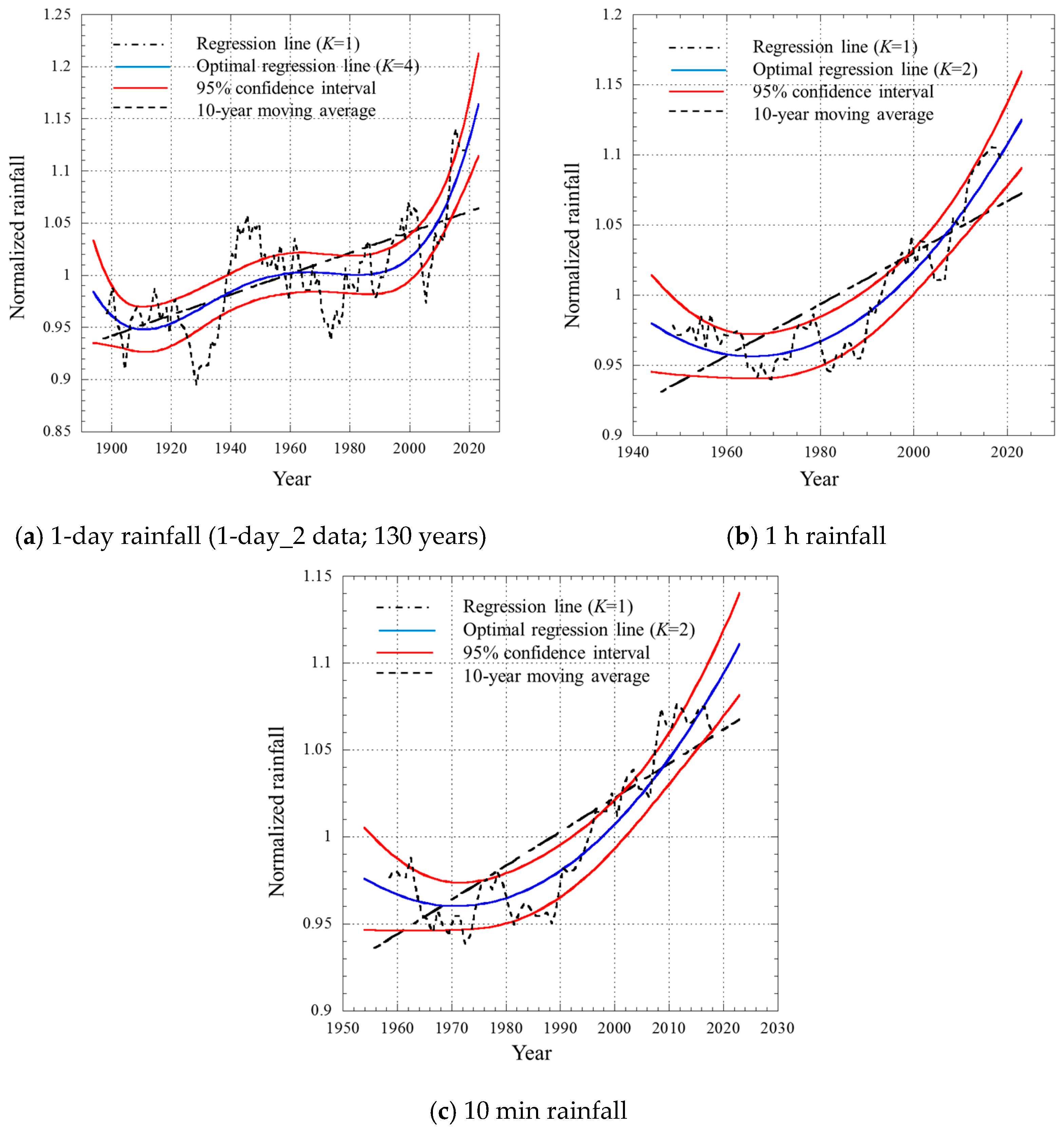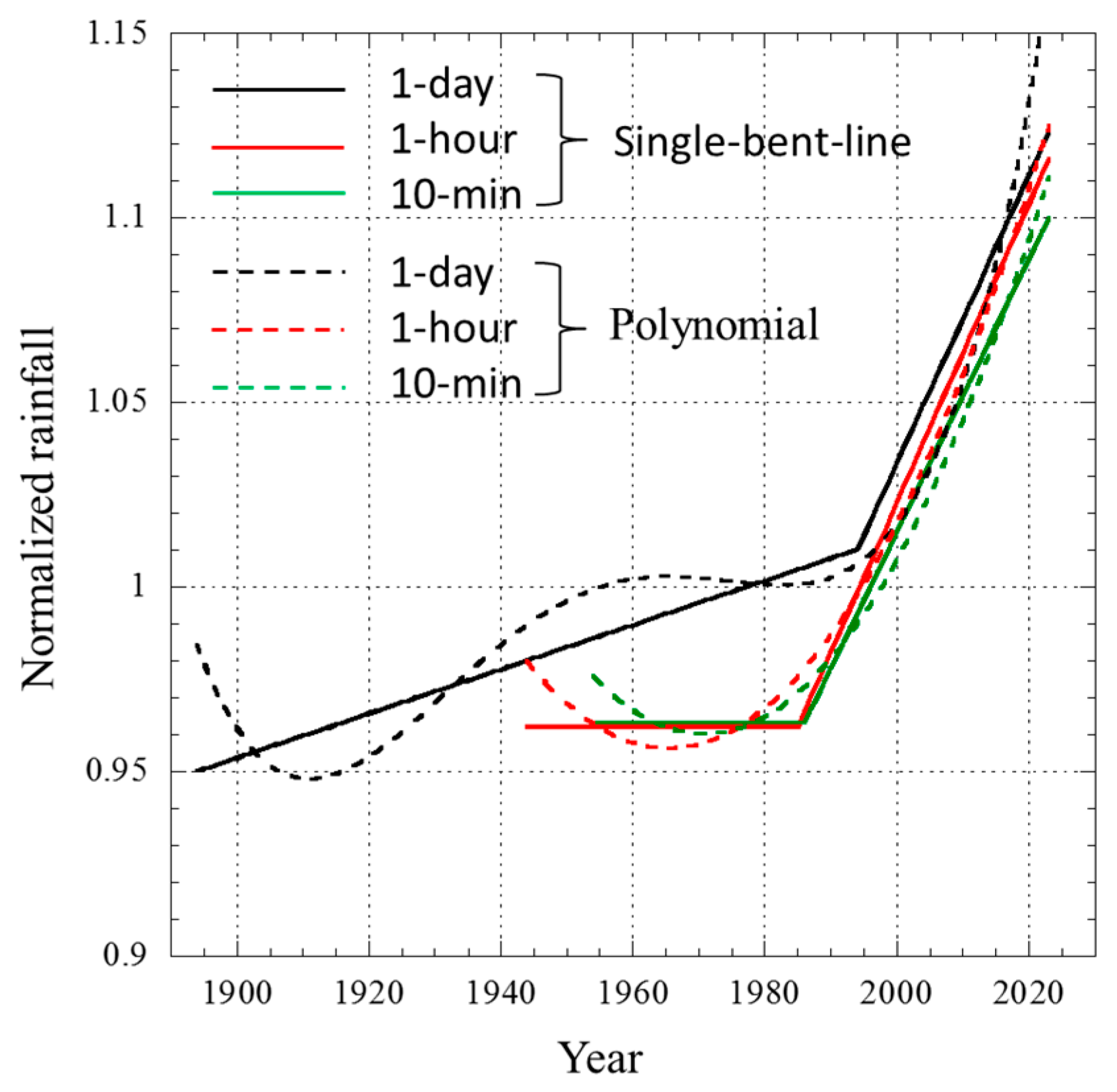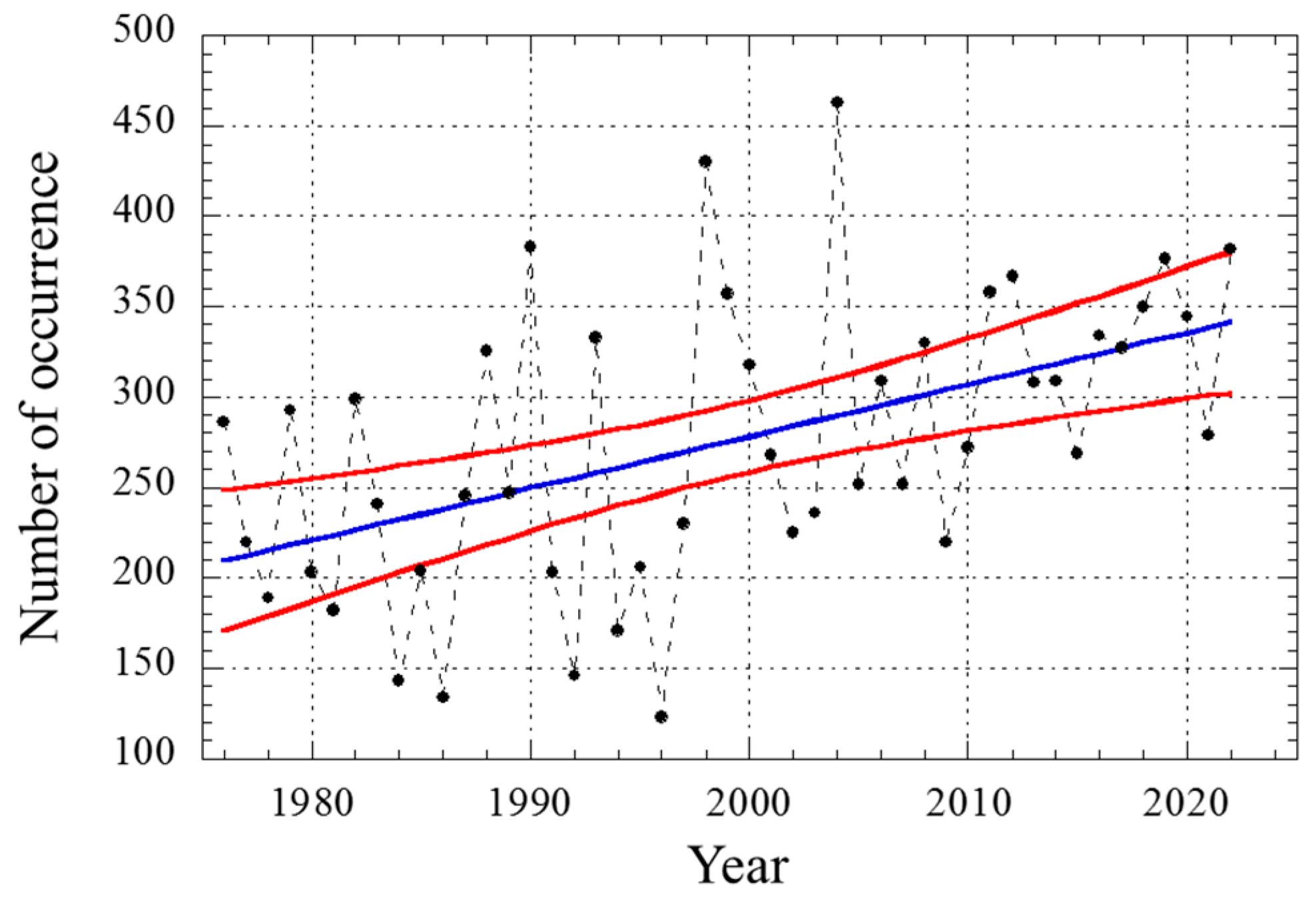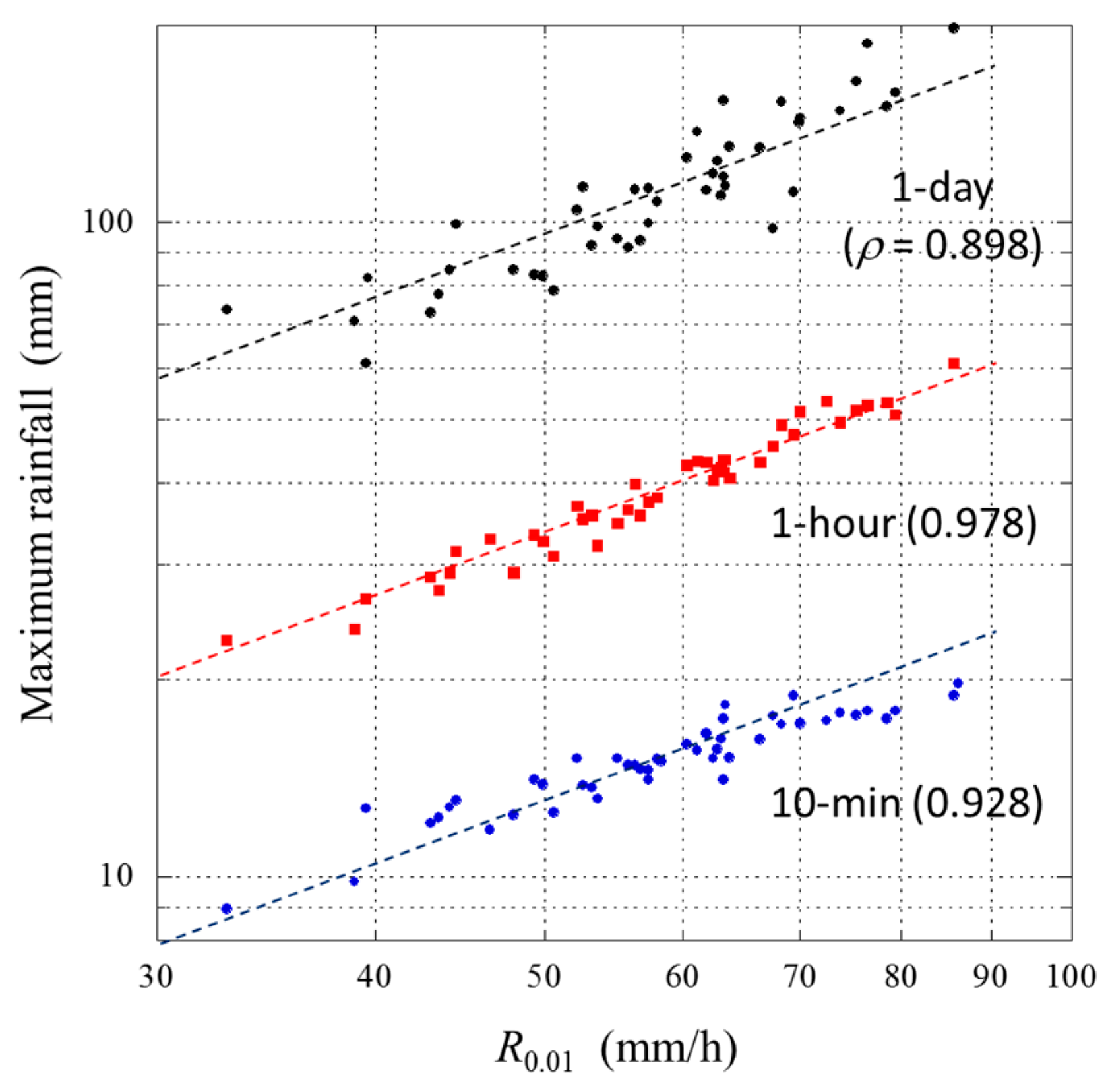Long-Term Variations in Extreme Rainfall in Japan for Predicting the Future Trend of Rain Attenuation in Radio Communication Systems
Abstract
1. Introduction
2. Rainfall Data
- (i)
- One-day rainfall (1-day_1): 45 locations in Japan; 100 years, from 1924 to 2023 (4500 data points). The data were mainly used in [19].
- (ii)
- One-day rainfall (1-day_2): 45 locations in Japan; 130 years, from 1894 to 2023 (5850 data points). The data are mainly used in this paper. Note that, for locations 8, 10, 11, 14, 18, 19, and 28, the start date is up to three years later than 1894; these missing data portions are filled with the average value over the observation period. (We have confirmed that the error caused by this manipulation is negligibly small.)
- (iii)
- One-hour rainfall: 45 locations across Japan; 80 years, from 1944 to 2023 (3600 data points).
- (iv)
- Ten-minute rainfall: 47 locations across Japan; 70 years, from 1954 to 2023 (3290 data points).
- Region A: North Japan (Hokkaido/Tohoku) (Sites 1–7 in Table 1).
- Region B: East Japan (Kanto, Chubu, and Hokuriku) (Sites 8–23).
- Region C: West Japan (Kinki, Chugoku, Shikoku, and Kyushu) (Sites 24–46).
- Region D: Okinawa and the Amami Islands (Site 47).
3. Modeling Approach
3.1. Maximum Likelihood Estimation of Parameter Values for a Selected Model
3.2. How to Choose a Model Function
- (1)
- Linear approximation
- (2)
- Polynomial approximation
- (3)
- Bent-line approximation
- (4)
- Other approximations
3.3. Guideline for Selecting a Better Model: AIC
4. Long-Term Variations in Annual Maximum Rainfall
4.1. Linear Approximation and Confidence Interval
4.2. Polynomial Approximation
4.3. Single-Bent-Line Approximation
4.4. Expected Future Trend of Extreme Rainfall
- (i)
- A linear increase of about 10% every 25 years will continue for several decades. Taking the year 2000 as the base year (hR = 1), it will be about hR = 1.2 around 2050. Furthermore, it will be about hR = 1.4 around 2100.
- (ii)
- The increasing trend will accelerate in the future.
- (iii)
- The increasing trend seen recently is part of a long steady state, and this increasing trend will eventually saturate.
5. Consideration on Consistency with Other Measurement Results in Japan
5.1. Increase in Heavy Rain Occurrence Frequency Evaluated by JMA
5.2. Heavy Rain Occurrence Increase Ratio vs. Rainfall Intensity Increase Ratio
6. Impact on Rain Attenuation Estimation Models
- (1)
- Rainfall increasing ratio hR should be reviewed in 2050 or so using the 1 h rainfall data available for Japan at that time in order to determine whether the projected trend remains unchanged or not.
- (2)
- Future trend projections should be extended to a global scale. As described, rainfall characteristics differ depending on the regional climate. Consequently, annual change trends will also differ. As discussed in [19], it is difficult to draw a conclusion for a specific location even when rainfall data are collected at that location over a period as long as 100 years. Thus, grouping together multiple sites located in similar climate zones and looking for common trends from the large amount of rainfall data that result would seem to offer an effective analytical approach. In such a case, it would be realistic to identify the change trend from the characteristics of the annual maximum 1 h rainfall following the method mentioned in this paper.
- (3)
- As shown in Equation (11), in addition to R0.01, to know the long-term change in the equivalent path length Le is also important for estimating rain attenuation. Because evaluating the equivalent path length involves using the trend in the spatial spread of the rain area, the estimation is more difficult than in the case of predicting the change in R0.01 from site-specific rainfall data. Accordingly, to develop a reliable rain attenuation prediction scheme in the future, research not only on R0.01 but also on Le will be essential.
7. Conclusions
- (1)
- Because rainfall varies widely from year to year, a noticeable long-term trend could not be confirmed using site-by-site data and a 95% confidence interval analysis, even with 100 years of data.
- (2)
- By dividing the annual maximum rainfall by the long-term average rainfall site-by-site and using these normalized values in the analysis, an increasing trend of more than 10% was identified [19].
- (3)
- By applying non-linear function approximations whose optimal order is determined based on the AIC, the increasing trend became more noticeable from the 1990s onward.
- (4)
- A linear relationship was found between R0.01 and the long-term average of the annual maximum rainfall values for the three types of rainfall (1-day, 1 h and 10 min). An especially high correlation (0.978) was observed for the 1 h rainfall case.
- (5)
- Considering the above, we can expect that the long-term variation of R0.01 will follow the same trend as that of 1 h rainfall. If this is the case, then the R0.01 database should be revised in the near future, taking the increasing ratio hR into account.
Funding
Data Availability Statement
Conflicts of Interest
References
- ITU-R. Propagation Data and Prediction Methods Required for the Design of Earth-Space Telecommunication Systems; Document ITU-R, ITU-R Rec. P.618-14; ITU-R: Geneva, Switzerland, 2023. [Google Scholar]
- ITU-R. Propagation Data and Prediction Methods Required for the Design of Terrestrial Line-of-Sight Systems; Document ITU-R, ITU-R Rec. P.530-18; ITU-R: Geneva, Switzerland, 2021. [Google Scholar]
- ITU-R. Characteristics of Precipitation for Propagation Modelling; Document ITU-R, ITU-R Rec. P.837-7; ITU-R: Geneva, Switzerland, 2017. [Google Scholar]
- MIC. Radio Regulation-Related Inspection Standard for Fixed Radio Station (In Japanese); The Ministry of Internal Affairs and Communications (MIC): Tokyo, Japan, 2011. [Google Scholar]
- Ono, K.; Karasawa, Y. M-distribution-based rain attenuation distribution prediction method introducing safety factor. IEICE Trans. Commun. 2008, J91-B, 169–187. (In Japanese) [Google Scholar]
- IPCC. Climatic Change 2013: The Physical Science Basis; IPCC: Geneva, Switzerland, 2013. [Google Scholar]
- JMA. Global Warming Prediction Information (In Japanese); Japan Meteorological Agency: Tokyo, Japan, 2017; Volume 9, Available online: https://www.data.jma.go.jp/cpdinfo/GWP/Vol9/pdf/all.pdf (accessed on 4 July 2025).
- JMA. Japan’s Climate Change 2020 (In Japanese); Japan Meteorological Agency: Tokyo, Japan, 2020; Available online: https://www.data.jma.go.jp/cpdinfo/ccj/index.html (accessed on 4 July 2025).
- Trenberth, K.E. Changes in precipitation with climate change. Clim. Res. 2011, 47, 123–138. [Google Scholar] [CrossRef]
- Adler, R.F.; Sapiano, M.R.P.; Huffman, G.J.; Wang, J.-J.; Gu, G.; Bolvin, D.; Chiu, L.; Schneider, U.; Becker, A.; Nelkin, E.; et al. The global precipitation climatology project (GPCP) monthly analysis (new version 2.3) and a review of 2017 global precipitation. Atmosphere 2018, 9, 138. [Google Scholar] [CrossRef] [PubMed]
- Donat, M.G.; Lowry, A.L.; Alexander, L.V.; O’Gorman, P.A.; Maher, N. More extreme precipitation in the world’s dry and wet regions. Nat. Clim. Chang. 2016, 6, 508–513. [Google Scholar] [CrossRef]
- Shiogama, H.; Imada, Y.; Mori, M.; Mizuta, R.; Stone, D.; Yoshida, K.; Arakawa, O.; Ikeda, M.; Takahashi, C.; Arai, M.; et al. Attributing historical changes in probabilities of record-breaking daily temperature and precipitations extreme events. SOLA 2016, 12, 225–231. [Google Scholar] [CrossRef]
- Allan, R.P.; Soden, B.J.; O John, V.; Ingram, W.; Good, P. Current changes in tropical precipitation. Environ. Res. Lett. 2010, 5, 025205. [Google Scholar] [CrossRef]
- Groisman, P.Y.; Knight, R.W.; Easterling, D.R.; Karl, T.R.; Hegerl, G.C.; Razuvaev, V.N. Trends in intense precipitation in the climate record. J. Clim. 2005, 18, 1326–1350. [Google Scholar] [CrossRef]
- Lenderink, G.; Mok, H.Y.; Lee, T.C.; van Oldenborgh, G.J. Scaling and trends of hourly precipitation extremes in two different climate zones—Hong Kong and the Netherlands. Hydrol. Earth Syst. Sci. 2011, 15, 3033–3041. [Google Scholar] [CrossRef]
- Zhou, Y.; Lau, W.K. The relationships between the trends of mean and extreme precipitation. Int. J. Clim. 2017, 37, 3883–3894. [Google Scholar] [CrossRef]
- Demirdjian, L.; Zhou, Y.; Huffman, G.J. Statistical modeling of extreme precipitation with TRMM data. J. Appl. Meteorol. Clim. 2018, 57, 15–30. [Google Scholar] [CrossRef] [PubMed]
- JMA. Past Weather Data Search (in Japanese). Japan Meteorological Agency Open Website. Available online: https://www.data.jma.go.jp/obd/stats/etrn/index.php (accessed on 4 July 2025).
- Karasawa, Y. Long-term statistical properties of extreme rainfall data in Japan. IEEE Trans. Geosci. Remote Sens. 2024, 62, 4707912. [Google Scholar] [CrossRef]
- Akaike, H. A new look at the statistical model identification. IEEE Trans. Autom. Control 1974, 19, 716–723. [Google Scholar] [CrossRef]
- JMA. Past Changes in Heavy Rain and Extremely Hot Days (Extreme Phenomena), (In Japanese); Japan Meteorological Agency: Tokyo, Japan, 2025; Available online: https://www.data.jma.go.jp/cpdinfo/extreme/extreme_p.html (accessed on 4 July 2025).
- Hosoya, Y. An estimation method for one-minute rain distributions at various locations in Japan. IEICE Trans. Commun. 1988, J71-B, 256–262. (In Japanese) [Google Scholar]
- ITU-R. Specific Attenuation Model for Rain for Use in Prediction Methods; Document ITU-R, ITU-R Rec. P.838-3; ITU-R: Geneva, Switzerland, 2005. [Google Scholar]
- Yamada, M.; Karasawa, Y.; Yasunaga, M.; Arbesser-Rastburg, B. An improved prediction method for rain attenuation in satellite communications operating at 10–20 GHz. Radio Sci. 1987, 22, 1053–1062. [Google Scholar] [CrossRef]
- Ono, K.; Karasawa, Y. An accurate conversion method of different integration rate CDF using M-distribution applicable to all over Japan. IEICE Trans. Commun. 2007, J90-B, 266–279. (In Japanese) [Google Scholar]
- Karasawa, Y.; Matsudo, T. One-minute rain rate distributions in Japan derived from AMeDAS one-hour rain rate data. IEEE Trans. Geosci. Remote Sens. 1991, 29, 890–898. [Google Scholar] [CrossRef]










| No. | Site | Region | 1-day_1 | 1-day_2 | 1-h | 10-min | R0.01 |
|---|---|---|---|---|---|---|---|
| 1 | Sapporo | A | 73.65 | 72.55 | 23.01 | 8.93 | 32.9 |
| 2 | Aomori | A | 70.81 | 70.12 | 23.93 | 9.84 | 38.9 |
| 3-1 | Morioka | A | 77.79 | - | 27.40 | 12.33 | 43.5 |
| 3-2 | Miyako | A | - | 124.29 | - | - | 46.3 |
| 4 | Akita | A | 83.13 | 85.12 | 33.31 | 14.10 | 49.3 |
| 5-1 | Ishinomaki | A | 82.39 | 83.80 | - | - | 36.9 |
| 5-2 | Sendai | A | - | - | 32.89 | 11.80 | 46.5 |
| 6 | Yamagata | A | 72.80 | 74.37 | 28.77 | 12.08 | 43.0 |
| 7 | Fukushima | A | 84.61 | 84.38 | 29.22 | 12.76 | 44.1 |
| 8 | Mito | B | 107.68 | 105.87 | 38.06 | 15.15 | 58.0 |
| 9 | Utsunomiya | B | 111.36 | 108.91 | 47.39 | 18.93 | 69.4 |
| 10 | Maebashi | B | 97.75 | 96.87 | 45.41 | 17.63 | 67.5 |
| 11 | Kumagaya | B | 113.89 | 113.43 | 43.33 | 18.32 | 63.4 |
| 12-1 | Katsuura | B | 144.50 | - | 51.43 | 17.15 | 70.0 |
| 12-2 | Choshi | B | - | 118.34 | - | - | 61.0 |
| 13 | Tokyo | B | 125.66 | 122.89 | 42.61 | 15.95 | 60.3 |
| 14 | Yokohama | B | 130.57 | 129.26 | 40.60 | 15.20 | 63.8 |
| 15 | Niigata | B | 78.80 | 77.85 | 30.88 | 12.56 | 50.6 |
| 16 | Fushiki | B | 91.65 | 91.39 | 36.39 | 14.83 | 55.8 |
| 17 | Kanazawa | B | 99.88 | 99.35 | 37.40 | 14.09 | 57.3 |
| 18 | Fukui | B | 92.37 | 93.94 | 35.67 | 13.67 | 53.2 |
| 19 | Kofu | B | 99.32 | 100.39 | 31.43 | 13.09 | 44.5 |
| 20 | Nagano | B | 60.97 | 60.43 | 26.63 | 12.71 | 39.5 |
| 21 | Gifu | B | 117.48 | 117.85 | 43.35 | 17.44 | 63.0 |
| 22-1 | Hamamatsu | B | 142.32 | 143.72 | - | - | 69.9 |
| 22-2 | Shizuoka | B | - | - | 53.31 | 17.35 | 72.5 |
| 23 | Nagoya | B | 109.81 | 111.37 | 42.31 | 16.26 | 63.1 |
| 24 | Tsu | C | 137.65 | 136.77 | 43.31 | 15.60 | 61.1 |
| 25 | Hikone | C | 94.38 | 98.88 | 34.77 | 15.17 | 55.0 |
| 26 | Kyoto | C | 112.24 | 108.60 | 43.08 | 16.57 | 61.9 |
| 27 | Osaka | C | 93.91 | 93.21 | 35.71 | 14.59 | 56.7 |
| 28 | Kobe | C | 104.35 | 102.78 | 36.83 | 15.16 | 52.2 |
| 29 | Wakayama | C | 118.76 | 117.60 | 40.34 | 15.17 | 62.4 |
| 30 | Sakai | C | 113.39 | 110.10 | 35.25 | 13.82 | 52.6 |
| 31 | Hamada | C | 112.45 | 108.54 | 39.82 | 14.83 | 56.3 |
| 32 | Okayama | C | 82.76 | 80.22 | 32.58 | 13.84 | 49.9 |
| 33 | Hiroshima | C | 112.96 | 109.72 | 37.45 | 14.56 | 57.3 |
| 34 | Shimonoseki | C | 124.13 | 121.27 | 41.82 | 15.65 | 62.8 |
| 35 | Tokushima | C | 153.35 | 154.84 | 49.06 | 17.12 | 68.3 |
| 36 | Tadotsu | C | 84.59 | 85.67 | 29.19 | 12.42 | 48.0 |
| 37 | Matsuyama | C | 98.59 | 96.87 | 32.06 | 13.17 | 53.6 |
| 38 | Kochi | C | 198.13 | 195.51 | 60.89 | 18.93 | 85.7 |
| 39 | Fukuoka | C | 130.07 | 124.69 | 43.00 | 16.21 | 66.4 |
| 40 | Saga | C | 148.36 | 142.08 | 49.50 | 17.81 | 73.8 |
| 41 | Nagasaki | C | 150.73 | 145.7 | 53.13 | 17.44 | 78.5 |
| 42 | Kumamoto | C | 164.47 | 154.96 | 51.61 | 17.66 | 75.4 |
| 43 | Oita | C | 154.05 | 150.87 | 41.55 | 14.07 | 63.3 |
| 44 | Miyazaki | C | 187.80 | 186.13 | 52.53 | 17.92 | 76.5 |
| 45 | Kagoshima | C | 158.01 | 154.90 | 50.92 | 17.95 | 79.3 |
| 46 | Nara | C | - | - | - | 15.02 | 58.3 |
| 47 | Naha | D | - | - | - | 19.75 | 86.2 |
| (total: site/year) | (45/100) | (45/130) | (45/80) | (47/70) | |||
| 1-day | 1-h | 10-min | |
|---|---|---|---|
| Number of sites | 45 | 45 | 47 |
| Period | 1924–2023 | 1944–2023 | 1954–2023 |
| (years) | (100) | (80) | (70) |
| Regression line | 1.14 | 1.16 | 1.14 |
| 95% Confidence interval | 1.09–1.20 | 1.10–1.21 | 1.10–1.19 |
| Rainfall | K | AIC | ∆AIC | ||
|---|---|---|---|---|---|
| 1-day | 1 | 0.16089 | −2956.79 | 5919.57 | 13.79 |
| 2 | 0.16069 | −2953.13 | 5914.26 | 8.472 | |
| 3 | 0.16059 | −2951.24 | 5912.49 | 6.704 | |
| 4 | 0.16035 | −2946.89 | 5905.78 | 0 | |
| 5 | 0.16033 | −2946.60 | 5907.19 | 1.409 | |
| 1-h | 1 | 0.13068 | −1445.22 | 2896.44 | 14.31 |
| 2 | 0.13009 | −1437.07 | 2882.13 | 0 | |
| 3 | 0.13009 | −1437.02 | 2884.04 | 1.913 | |
| 4 | 0.13003 | −1436.19 | 2884.37 | 2.241 | |
| 5 | 0.13002 | −1436.10 | 2886.20 | 4.070 | |
| 10-min | 1 | 0.08708 | −653.04 | 1312.07 | 13.57 |
| 2 | 0.08667 | −645.25 | 1298.51 | 0 | |
| 3 | 0.08662 | −644.32 | 1298.65 | 0.137 | |
| 4 | 0.08660 | −643.95 | 1299.90 | 1.392 | |
| 5 | 0.08657 | −643.37 | 1300.73 | 2.222 |
| Rainfall | p | AIC | ∆AIC | ||
|---|---|---|---|---|---|
| 1-day | 3 | 0.16067 | −2952.75 | 5913.50 | 7.72 |
| 4 | 0.16052 | −2949.95 | 5909.89 | 4.11 | |
| 1-h | 3 | 0.13003 | −1436.13 | 2880.25 | −1.88 |
| 4 | 0.13002 | −1436.05 | 2882.10 | −0.03 | |
| 10-min | 3 | 0.08661 | −644.10 | 1296.21 | −2.30 |
| 4 | 0.08659 | −643.78 | 1297.56 | −0.94 |
Disclaimer/Publisher’s Note: The statements, opinions and data contained in all publications are solely those of the individual author(s) and contributor(s) and not of MDPI and/or the editor(s). MDPI and/or the editor(s) disclaim responsibility for any injury to people or property resulting from any ideas, methods, instructions or products referred to in the content. |
© 2025 by the author. Licensee MDPI, Basel, Switzerland. This article is an open access article distributed under the terms and conditions of the Creative Commons Attribution (CC BY) license (https://creativecommons.org/licenses/by/4.0/).
Share and Cite
Karasawa, Y. Long-Term Variations in Extreme Rainfall in Japan for Predicting the Future Trend of Rain Attenuation in Radio Communication Systems. Climate 2025, 13, 145. https://doi.org/10.3390/cli13070145
Karasawa Y. Long-Term Variations in Extreme Rainfall in Japan for Predicting the Future Trend of Rain Attenuation in Radio Communication Systems. Climate. 2025; 13(7):145. https://doi.org/10.3390/cli13070145
Chicago/Turabian StyleKarasawa, Yoshio. 2025. "Long-Term Variations in Extreme Rainfall in Japan for Predicting the Future Trend of Rain Attenuation in Radio Communication Systems" Climate 13, no. 7: 145. https://doi.org/10.3390/cli13070145
APA StyleKarasawa, Y. (2025). Long-Term Variations in Extreme Rainfall in Japan for Predicting the Future Trend of Rain Attenuation in Radio Communication Systems. Climate, 13(7), 145. https://doi.org/10.3390/cli13070145





